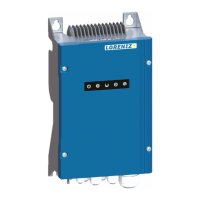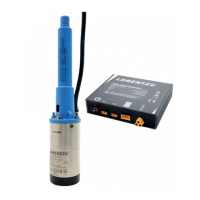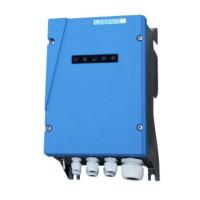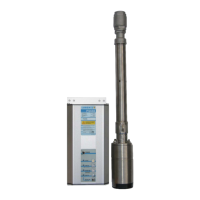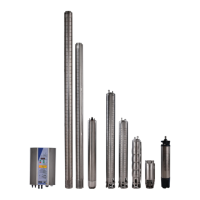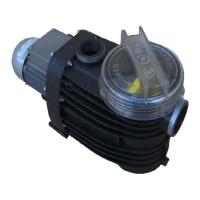Installation in a Surface Water Source5.5
This refers to a surface well, spring, pond, lake,
river or tank.
Positioning the pump The pump may be placed in an
inclined position with a min. angle of 30° if desired.
water starting at the SURFACE of the water in the source.
Increasing the submergence of the pump (placing it lower
in the source) will NOT cause it to work harder or to pump
less water. Avoid placing the pump close to the bottom
where it will pick up sediment.
Filtration at the pump intake PS pumps will tolerate
small amounts of sand, but you may need to filter out
larger debris that is normally found in a pond or stream.
You can construct a simple coarse screen to protect the
pump and to reduce the nuisance of debris in your water
system. One method is to wrap the pump with about 6-8
layers of loosely-woven fabric or screen, of a material that
will not decay or rust. Some suggestions are fiberglass win-
dow screen, agricultural shade cloth, or weed-barrier fabric
(available from nursery and landscaping suppliers). Bind
the fabric or screen with all-stainless hose clamps, rubber,
or polypropylene rope. Do not use nylon; it softens with
submersion in water. An improved method is to construct
a sealed pump enclosure from 4-6 in plastic pipe, with
many holes or slots to let water in. Then, wrap the screen
around that enclosure. This will distribute the flow through
a much larger area of screen. After cutting holes or slots in
the plastic pipe, wipe the inside carefully to remove plastic
shavings and dust.
WARNING for SIPHON APPLICATIONS
If a pump system has a vertical lift of
less than 33 ft (10 m) up from the
surface of the water source, and then
the water flows downhill to a lower point, a siphon
effect may cause suction at the pump outlet. This
will cause an upward thrust on the motor shaft,
resulting in damage to the motor. Prevent this by
installing an air vent or a vacuum breaker at the
high point on the pipe.
CAUTION The pump must be fully
submerged. A helical rotor pump may
overheat and stop (temporarily) if
the pump end is not fully submerged.
CAUTION High water temperature
can cause failure to start. Low
temperature can reduce lift and flow
capacity. This can occur in surface
water during weather extremes, due to temporary
expansion or contraction of the rubber stator. The
product specifications say: Optimum water temp. is
46°F to 72°F (8°C to 22°C). Other ranges are
available by special order. These performance
problems are temporary and will NOT damage the
pump. If you are uncertain about using the pump
you received, contact your supplier before you
install it.
Deep Well Setting — How Deep?5.6
PS pumps may be submersed as deep as necessary to
ensure reliable water supply. The lift load on the pump
is determined by the vertical head of water starting at
the SURFACE of the water in the source. Increasing the
submergence of the pump (placing it lower in the well) will
NOT cause it to work harder or to pump less water, nor will
it increase the stress or wear on the pump.
There are reasons NOT to set the pump near the bottom of
the well, if it is not necessary:
A deep setting will increase the size requirements, 1.
costs and weight of pipe and cable.
A deep setting may increase the chance of sand or 2.
sediment being drawn into the pump.
To make an informed decision, it is helpful to have accurate
data for your water source. In most places, drillers are
required to report the details and the performance of wells
that they drill. If you do not have the driller’s well record,
you may be able to obtain a copy from your regional gov-
ernment office that oversees ground water resources and
issues drilling permits. In USA, it is a state office, typically
called Department of Natural Resources or State Engineer’s
Office. However, the data may be missing or inaccurate, and
conditions can change over the years. In critical cases, it is
wise to have the well re-tested by a water well contractor.
Models 03, 03H, 04 and 04H have a small “vent hole” near
the top of the pump (photo). If the hole is not submersed,
it will suck air and prevent the pump from performing fully.
The purpose of this hole is to allow water to fill an internal
gap, to conduct heat away from the rubber stator.
River or stream To reduce the intake of sediment, do not
place the intake very close to the bottom of the stream or
pond. Secure the pump from logs and debris that may float
downstream. Use stainless steel wire rope or chain instead
of plastic safety rope (plastic rope will weaken in sunlight).
Consider digging a shallow well near the stream. This will
allow filtration of the water through the earth, and will
protect the pump from floating debris or human tampering.
CAUTION The low-water probe must
be positioned vertically, within 10°.
Normally, it is to be installed on the
pipe above the pump outlet, as
shown in section 5.9. This will only work if the
pump is installed vertically. If the pump is will NOT
be vertical, find an alternative way to mount or
suspend the probe, so that it is higher than the
pump, and in a vertical position.
Is a flow sleeve required? NO, not within the normal
temperature range. The PS pumps high-efficiency motor
generates very little heat. A conventional submersible
pump requires a flow sleeve to assist motor cooling when
installed in open water (not confined by a narrow casing).
It is a piece of 4-6 in pipe that surrounds the pump to
increase flow around the motor.
Depth of submersion PS pumps may be submersed as
deep as necessary to ensure reliable water supply. The lift
load on the pump is determined by the vertical head of
min. 30°
Minimum angle when positioning the Figure 18:
pump in an inclined position
